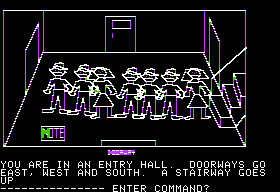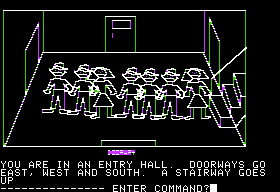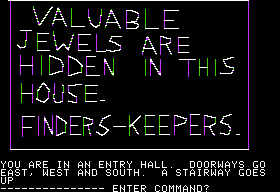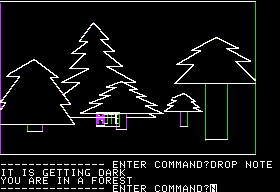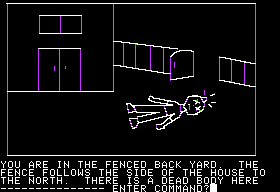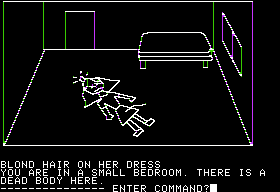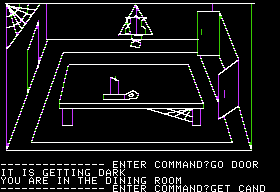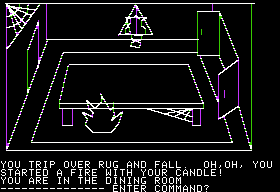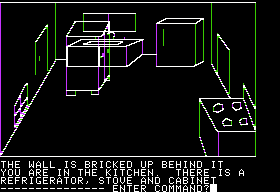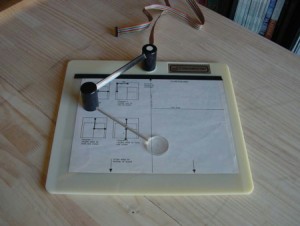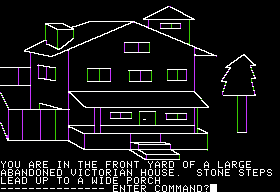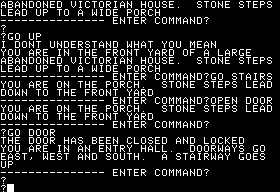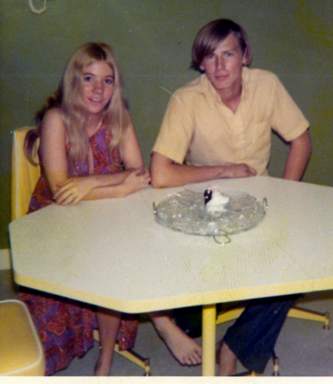Once Roberta sold Ken on the idea of Mystery House, he — typically enough, given his personality — threw himself into it. In just one month during which Ken continued to hold down a day job, the couple implemented Mystery House in its entirety, including the design, writing, illustrations, and programming (in 100% assembly language for speed and efficiency, during an era when even most commercial software was still unashamedly coded in BASIC). Now they had to decide what to do with it.
When Scott Adams created Adventureland almost two years earlier, virtually all microcomputer software was marketed directly by the programmers / entrepreneurs who had created it, through advertisements they made themselves and placed in computer stores, user groups, and magazines and through semi-professional organizations like the TRS-80 Software Exchange. Thus, Adams had little choice but to cobble together packaging using business cards and baby-formula liners and have at it. Now, though, publishers — not least Adams’s own Adventure International — were rapidly professionalizing microcomputer software. The industry was still small, but it was growing rapidly, giving creators like Ken and Roberta with a novel product more options. The biggest of the publishers in the early Apple II market was called Programma International. (One of the amusing aspects of these early publishers is their fondness for the aspirational “International” even though their industry still existed almost exclusively inside the U.S.) In addition to a nice selection of tools for programming and productivity, Programma also published plenty of games. They instantly saw the potential of Mystery House when Ken and Roberta showed it to them. They offered a 25 percent royalty, promising the couple could easily earn $9000 on the game by the end of the year.
Ken and Roberta said no thanks. To understand why, you have to remember what kind of person Ken was — ambitious, driven, and unashamedly focused on the proverbial bottom line. He had already registered a company called On-Line Systems when he started planning that FORTRAN compiler. Why not sell it themselves, and keep all the money? To make the idea even more attractive, a friend of his had a simplistic little shooting game called Skeet Shoot that he was willing to let Ken market. With two actual products to sell, On-Line Systems was born in earnest in May of 1980. Figuring what was good enough for kidnappers and serial killers was good enough for them, Ken and Roberta made some advertising fliers by cutting letters and words out of magazines, pasting them onto backing stock, and photocopying the lot. With 100 blank disks, Ziploc bags for packaging, and a couple of magazine advertisements, they were in business.
A few months ago I poked a bit of fun at Scott Adams for claiming credit on his website for “starting the entire multi billion dollar a year computer game industry.” The funny thing is, in a sense Ken and Roberta Williams could make a much more supportable claim to exactly that. Let me explain.
Having decided to go it on their own, Ken and Roberta’s first sales tactic was to visit every local computer store they knew to demonstrate their products. Luckily, there were quite a few of these; Ken and Roberta were living at the time in California’s Simi Valley, close to the sprawl of Los Angeles. Ken also called his younger brother John, at university in Illinois, to do the same there. John knew nothing about computers, and was very surprised to find that Ken’s new product was a game of all things, for he considered Ken a “chronic workaholic” who “didn’t have a fun bone in his body.” As he described in the tenth-anniversary issue of Sierra’s in-house magazine, John was soon traveling the country hawking On-Line System’s wares to computer stores:
When I visited a computer store, be it in Peoria, Illinois or New Orleans, Louisiana, the game was a hit. Never mind that I had to hand the game disk to the retailer I was trying to “sell” the game to because I didn’t know how to boot a game disk from BASIC. I always walked out of the store with an order. It seemed that Roberta and Ken had written a game that all those Apple owners out there (of which we knew there were at least 50,000) definitely wanted to play.
At this time, dozens of software publishers were either born or birthing, and some 1200 computer stores were doing business around the country, eager for programs to sell to their customers. What was missing was some means of connecting the two groups — in other words, distributors. Software companies like Adventure International were forced to accept orders directly from hundreds of individual retailers. An online profile of software distributor Merisel describes the problems this created:
In 1980 the computer software industry was in its infancy. Programs were written primarily in one-person shops by computer junkies, who did it more for love than for money. Getting this software to the 1,200 or so owners of computer retail stores was, at best, a hit-or-miss affair. If the software writer went on vacation, for example, the factory was closed and shipments stopped. Deciding which software to buy was even trickier. Approximately 95 percent of personal computer software was being sold by retail dealers, but few were in a position to evaluate and select stock from the huge number of programs available.
Ken, a keen business mind if ever there was one, forged connections with Adams and many other publishers to begin distributing their games to retail. (I’m almost certain this is the source of the odd claim that Adams made while being interviewed for Jason Scott’s excellent Get Lamp documentary — and repeated by Jason in an earlier comment on this blog — that Ken Williams somehow got his start with Adventure International as a “salesman.”) Within months, feeling overwhelmed with trying to run a software publisher and a software distributor and be a developer, Ken sold the distribution operation to Robert Leff, a colleague he knew from his years as a programmer for hire, for the uncharacteristically low price of just $1300. Leff in turn built the operation into SoftSel, a behemoth that came to dominate the retail software market behind the scenes, capable of making or breaking a publisher or even computing platform by the titles it chose to accept and the commitment it showed to them. Leff, a name few people outside the software industry knew even then, became one of the most powerful figures in the 1980s computing world. (SoftSel changed its name in 1990 to the aforementioned Merisel.)
There is a certain tang of the bittersweet to this progress. By setting up SoftSel, Ken and Leff effectively ensured that future hackers would not realistically be able to do what Ken and Roberta, Scott Adams, Lance Micklaus, and so many others had done, building viable businesses out of their kitchens and garages on nothing but new ideas and a talent for hacking. Eventually the grip held on the industry by distributors like SoftSel and the huge, conservative publishers that they aided and abetted would come to be blamed for the lack of innovation in and seemingly perpetual adolescence of the whole field of computer and video gaming, a state of affairs that has only begun to be satisfactorily remedied in recent years with the rise of online distribution. At the same time, though, the rapidly growing software industry of 1980 simply needed a SoftSel to get software efficiently into the hands of ever growing numbers of consumers in those days of 300-baud modems and primitive telecommunications. In seeing this need and taking steps to meet it, Ken may have done more to shape the future than he would in all his future efforts with On-Line Systems (soon, of course, to be renamed Sierra). Chalk it up as the last huge step toward the professionalization of software, with all the good and bad that that implies.
Chalk it up also as another example of Ken’s savvy. Other than Bill Gates, I don’t know of another figure in the early PC world who combined such technical acumen with such an instinct for business. His influence is made all the more remarkable when one considers what a late starter he was in comparison to his peers, not getting into the game as he did until 1980. And believe me, there’s more significant stuff that Ken’s fingerprints are all over… we just haven’t gotten there yet.
But back to Mystery House, which was doing pretty well in its own right. Steven Levy writes, “Ken and Roberta made eleven thousand dollars that May. In June, they made twenty thousand dollars. July was thirty thousand.” (And remember, these are 1980 dollars.) Around that time Ken quit his day job, and the Williamses began preparing to pull up stakes and fulfill a lifelong dream — to live in the country, specifically the little town of Coarsegold, not far from Yosemite National Park. Meanwhile, having included their home phone number with Mystery House, both spent hours on the phone doling out hints and advice to frustrated players.
In the midst of this frenzy of activity, Ken and Roberta were also working hard on a new game to consolidate On-Line Systems’s position in the industry. Mystery House had changed everything by having pictures, but, let’s face it, they weren’t really very nice pictures. Their next game would change that by adding color to the equation.
